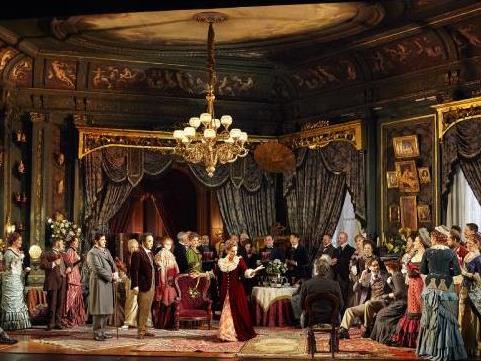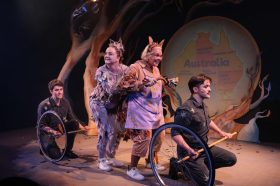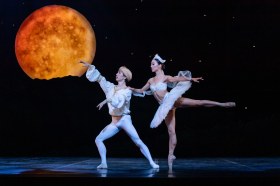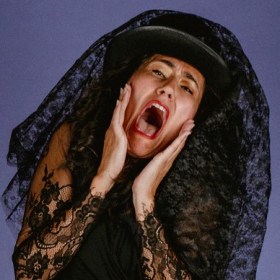Opera Australia’s lavish production of La Traviata. Picture: Keith Saunders
Staging the 200th performance of any production means risking staidness, despite a well-oiled rollout. Nothing could be more contrary to Opera Australia’s revival of its 1994 production of Verdi’s La Traviata.
The production has come a long way since it was premiered in Paris in 1853 with a contemporary setting that was harshly criticised. The main character, Violetta, suffers from consumption, an illness that causes its victims to waste away, but the overweight middle-aged soprano of the day was deemed impalpable. It was a flop.
In a curious turn of events, that soprano was in fact Verdi’s mistress Giuseppina Strepponi – a relationship that strangely echoed Act II of La Traviata where a father disapproved of an unsuitable lover. The real life lovers married in 1859.
Verdi rethought his opera, and a year later performed it again in a traditional setting. It worked, and has become the most performed opera in the world.
Director Elijah Moshinsky has stuck with that winning traditional formula. His opulent production was a feast for the senses.
As the curtain raised on Michael Yeargan’s grand set and the luscious costumes by Peter Hall, audiences are immediately seduced into Moshinsky’s world. And with one of Verdi’s best-known arias falling early in the first Act, Brindisi (a drinking song), this is one party you are pleased to be part of.
Opera Australia promotes it simply: ‘Verdi wrote big, beautiful melodies and expressive, dramatic orchestral music.’
Conductor Renato Palumbo did a superb job rolling out that drama and range of emotions, from a boisterous drinking song to a sensitive aria on Violetta’s deathbed.
In too many operas the chorus is placed off-stage, sounding muffled and at sea, whereas Verdi has used it to build the richness of this story. It was particular strong in Act II with ‘Libiamo ne lieti calici’ (Let’s drink from the joyful cups), and their presence in this opera was a wonderful balance its intimacy.
The jewel of this opera is the diva. As the consumption-riddled courtesan, Albanian soprano Ermonela Jaho delivered this role with perfection; her vocal range, control and sensitivity were pure mastery, and her dramatic command of the character convincing and connecting.
She first sung the role at Covent Garden replacing a sick soloist. Eight years later she has come to own this role internationally.
The story is one of true romance – a sure seller. Violetta gives up her partying days for true love and moves to the country. But this picture of happiness soon spirals into tragedy as her reputation catches up with her and her lover’s father implores her to leave. Skirting death eventually catches up with Violetta, and La Traviata delivers a dramatic curtain aria.

Ho-Yoon Chung’s delivery of Alfredo grew with the performance in a convincing portrayal; Photo Keith Saunders
The besotted Alfredo, Korean tenor Ho-Yoon Chung, held his own against Jaho. While his Brindisi may have been stronger, I suspect that would have warmed up into the season.
Jaho had a joy to his voice that suits this role, and that tenderness was delivered superbly in the third Act at the deathbed of the doomed heroine.
Alfredo’s father, Giorgio Germont, sung by Australian baritone Jose Carbo, demonstrated again why he is regarded as one or our best.
His renditions of ‘Pura siccome un angelo’ (Pure as an angel, God gave me a daughter) and ‘Di Provenza il mar’ (Who erased the sea, the land of Provence from your heart?) are smooth as honey and deep as a rolling sea.

Violetta with Germont has a strong rapport in Opera Australia’s production of La Traviata; Photo Keith Saunders
The heartfelt duet between Germont and Violetta – Pura siccome un angelo Iddio mi diè una figlia (‘Pure as an angel, God gave me a daughter’) in Act II is heavenly, as joy is snuffed by a sense of warped loyalty, and Violetta’s fleeting happiness of a country life with Alfredo comes to an end.
Returning to Paris, the sets move the audience between opulence and starkness. By this point in the opera the audience is totally transfixed by the story and delivery by this incredible cast. This is everything we are told opera should be.
As the production progresses through the acts, punctuated as seasons, we appreciate the full brilliance of Nigel Levings’ lighting, which works beautifully as the sets evolve this drama.
The minimal set of the third Act amplifies the tableaux vivant, as all the frills and frivolities are stripped back to raw human emotion. Jaho’s incredible voice both uplifts and saddens. Her range is amazing. If we were to use theatre jargon – she is a showstopper.

Ermonela Jaho as Violetta, attended by the doctor in the third Act. Photo Keith Saunders
Jaho’s “diva antics” at curtain call, when she was seemingly unable to pull herself out of her thespian moment, barely acknowledging the audience’s praise, was the only thing that soured the opening night. But then, she is one of the hottest sopranos performing today.
This production is as vibrant as its first outing on the Australian stage 23 years ago.
Punch and pace have sadly become the way we navigate opinion these days and first impressions of opera can often be tainted by misguided public perceptions. Opera has often struggled to stay in sync with those contemporary tastes. Under Moshinsky eye, La Traviata magically ticks both boxes – it appeals to tradition and it seduces the newly converted.
Rating: 5 out of 5
La Traviata
Opera Australia, Joan Sutherland Theatre
3 February – 1 April
Director: Elijah Moshinsky
Conductor: Renato Palumbo
Revival Director: Hugh Halliday
Set Designer: Michael Yeargan
Costume Designer: Peter J Hall
Lighting Designer: Nigel Levings





